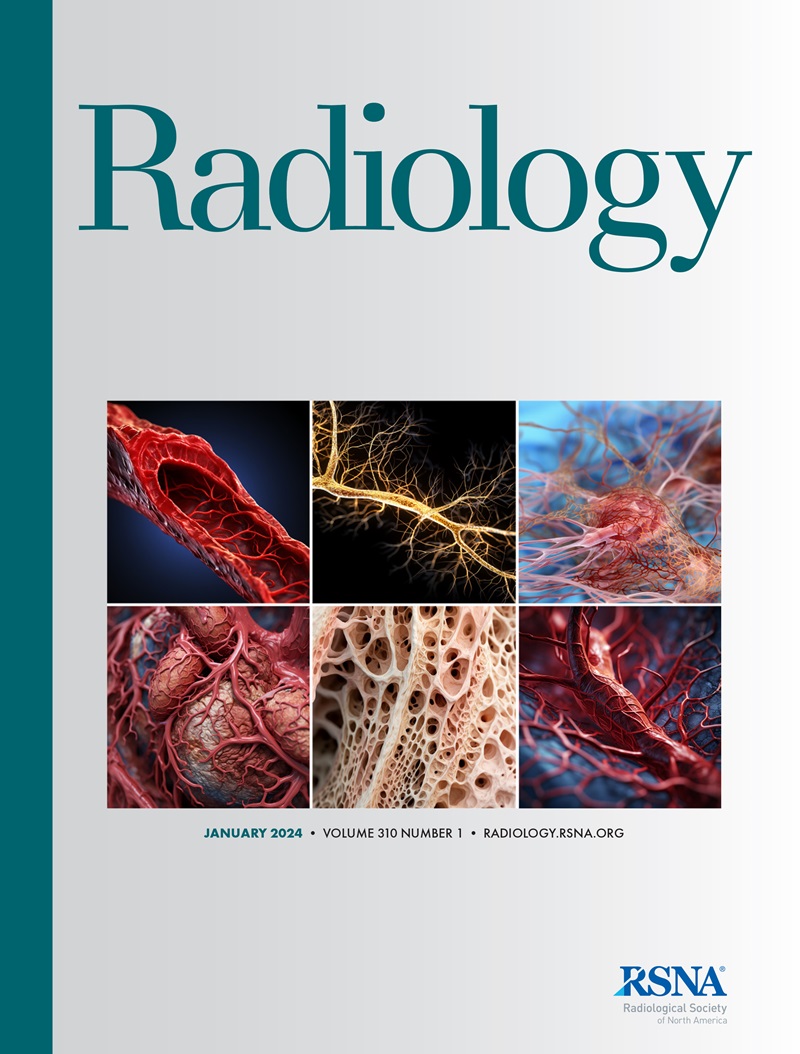Yura Ahn, Eun Ji Lee, Jihye Yun, Hye Jeon Hwang, Yeon-Mok Oh, Myeong Jun Kim, Seung Bin Bae, Donghoon Yu, Jaeyoun Yi, Sang Min Lee, Joon Beom Seo
求助PDF
{"title":"非对比CT对肺气肿空洞的纵向追踪:动态模式和临床关系。","authors":"Yura Ahn, Eun Ji Lee, Jihye Yun, Hye Jeon Hwang, Yeon-Mok Oh, Myeong Jun Kim, Seung Bin Bae, Donghoon Yu, Jaeyoun Yi, Sang Min Lee, Joon Beom Seo","doi":"10.1148/radiol.243239","DOIUrl":null,"url":null,"abstract":"<p><p>Background Emphysema holes change longitudinally in various ways, but current CT measurements lack the ability to fully capture these changes beyond measuring the extent of emphysema. Purpose To track emphysema holes longitudinally, group them according to their dynamics, and investigate their relationship with change in forced expiratory volume in 1 second (FEV<sub>1</sub>), disease progression, and mortality. Materials and Methods In this secondary analysis, data from participants in the Korean Obstructive Lung Disease cohort study from June 2005 to October 2013 who completed baseline and 6-year follow-up CT with identical protocols were evaluated. Emphysema holes were identified and tracked using deep learning-based software and were grouped based on changes in diameter (in 2-mm increments) as increased in diameter (including both new and enlarged preexisting holes), stable, or decreased in diameter. The percentage of hole volume in each group and its relationship with FEV<sub>1</sub> decline were analyzed using multiple linear regression, and comparisons were made among the subsets of participants on the basis of emphysema progression or severity. Overall survival according to the volume cutoff of the holes with increased diameter was compared using the log-rank test. Results Among 108 participants (mean age, 63.4 years ± 6.7 [SD]; 104 male), 39 had emphysema progression (based on whether the change in low-attenuation area less than -950 HU [LAA-950] exceeded 3.7%). Enlarged preexisting holes were marginally associated with a greater decline in FEV<sub>1</sub> (β = -.25, <i>P</i> = .049). Compared with those without emphysema progression, those with emphysema progression had a significantly greater percentage of hole volume and percentage of holes with increased diameter (7.7% vs 1.9% and 18.3% vs 6.2%, respectively; both <i>P</i> < .001), with most of the volume attributed to new holes. Participants with severe disease or emphysema (FEV<sub>1</sub> < 50% or LAA-950 ≥ 14%) had more holes with increased diameter (5.1% vs 2.4% [<i>P</i> = .02] and 6.7% vs 1.2% [<i>P</i> < .001], respectively) and new holes (3.8% vs 1.7% [<i>P</i> = .01] and 4.7% vs 1.1% [<i>P</i> < .001], respectively). Participants with 5% or greater volume of increased-diameter holes had worse overall survival (log-rank <i>P</i> < .001). Conclusion Emphysema hole-tracking results showed that a greater volume of holes that increased in diameter were related to change in FEV<sub>1</sub>, disease progression, and mortality. © RSNA, 2025 <i>Supplemental material is available for this article</i>. See also the editorial by van Beek in this issue.</p>","PeriodicalId":20896,"journal":{"name":"Radiology","volume":"316 1","pages":"e243239"},"PeriodicalIF":12.1000,"publicationDate":"2025-07-01","publicationTypes":"Journal Article","fieldsOfStudy":null,"isOpenAccess":false,"openAccessPdf":"","citationCount":"0","resultStr":"{\"title\":\"Longitudinal Tracking of Emphysema Holes at Noncontrast CT: Dynamic Patterns and Clinical Relationships.\",\"authors\":\"Yura Ahn, Eun Ji Lee, Jihye Yun, Hye Jeon Hwang, Yeon-Mok Oh, Myeong Jun Kim, Seung Bin Bae, Donghoon Yu, Jaeyoun Yi, Sang Min Lee, Joon Beom Seo\",\"doi\":\"10.1148/radiol.243239\",\"DOIUrl\":null,\"url\":null,\"abstract\":\"<p><p>Background Emphysema holes change longitudinally in various ways, but current CT measurements lack the ability to fully capture these changes beyond measuring the extent of emphysema. Purpose To track emphysema holes longitudinally, group them according to their dynamics, and investigate their relationship with change in forced expiratory volume in 1 second (FEV<sub>1</sub>), disease progression, and mortality. Materials and Methods In this secondary analysis, data from participants in the Korean Obstructive Lung Disease cohort study from June 2005 to October 2013 who completed baseline and 6-year follow-up CT with identical protocols were evaluated. Emphysema holes were identified and tracked using deep learning-based software and were grouped based on changes in diameter (in 2-mm increments) as increased in diameter (including both new and enlarged preexisting holes), stable, or decreased in diameter. The percentage of hole volume in each group and its relationship with FEV<sub>1</sub> decline were analyzed using multiple linear regression, and comparisons were made among the subsets of participants on the basis of emphysema progression or severity. Overall survival according to the volume cutoff of the holes with increased diameter was compared using the log-rank test. Results Among 108 participants (mean age, 63.4 years ± 6.7 [SD]; 104 male), 39 had emphysema progression (based on whether the change in low-attenuation area less than -950 HU [LAA-950] exceeded 3.7%). Enlarged preexisting holes were marginally associated with a greater decline in FEV<sub>1</sub> (β = -.25, <i>P</i> = .049). Compared with those without emphysema progression, those with emphysema progression had a significantly greater percentage of hole volume and percentage of holes with increased diameter (7.7% vs 1.9% and 18.3% vs 6.2%, respectively; both <i>P</i> < .001), with most of the volume attributed to new holes. Participants with severe disease or emphysema (FEV<sub>1</sub> < 50% or LAA-950 ≥ 14%) had more holes with increased diameter (5.1% vs 2.4% [<i>P</i> = .02] and 6.7% vs 1.2% [<i>P</i> < .001], respectively) and new holes (3.8% vs 1.7% [<i>P</i> = .01] and 4.7% vs 1.1% [<i>P</i> < .001], respectively). Participants with 5% or greater volume of increased-diameter holes had worse overall survival (log-rank <i>P</i> < .001). Conclusion Emphysema hole-tracking results showed that a greater volume of holes that increased in diameter were related to change in FEV<sub>1</sub>, disease progression, and mortality. © RSNA, 2025 <i>Supplemental material is available for this article</i>. See also the editorial by van Beek in this issue.</p>\",\"PeriodicalId\":20896,\"journal\":{\"name\":\"Radiology\",\"volume\":\"316 1\",\"pages\":\"e243239\"},\"PeriodicalIF\":12.1000,\"publicationDate\":\"2025-07-01\",\"publicationTypes\":\"Journal Article\",\"fieldsOfStudy\":null,\"isOpenAccess\":false,\"openAccessPdf\":\"\",\"citationCount\":\"0\",\"resultStr\":null,\"platform\":\"Semanticscholar\",\"paperid\":null,\"PeriodicalName\":\"Radiology\",\"FirstCategoryId\":\"3\",\"ListUrlMain\":\"https://doi.org/10.1148/radiol.243239\",\"RegionNum\":1,\"RegionCategory\":\"医学\",\"ArticlePicture\":[],\"TitleCN\":null,\"AbstractTextCN\":null,\"PMCID\":null,\"EPubDate\":\"\",\"PubModel\":\"\",\"JCR\":\"Q1\",\"JCRName\":\"RADIOLOGY, NUCLEAR MEDICINE & MEDICAL IMAGING\",\"Score\":null,\"Total\":0}","platform":"Semanticscholar","paperid":null,"PeriodicalName":"Radiology","FirstCategoryId":"3","ListUrlMain":"https://doi.org/10.1148/radiol.243239","RegionNum":1,"RegionCategory":"医学","ArticlePicture":[],"TitleCN":null,"AbstractTextCN":null,"PMCID":null,"EPubDate":"","PubModel":"","JCR":"Q1","JCRName":"RADIOLOGY, NUCLEAR MEDICINE & MEDICAL IMAGING","Score":null,"Total":0}
引用次数: 0
引用
批量引用

 求助内容:
求助内容: 应助结果提醒方式:
应助结果提醒方式:


